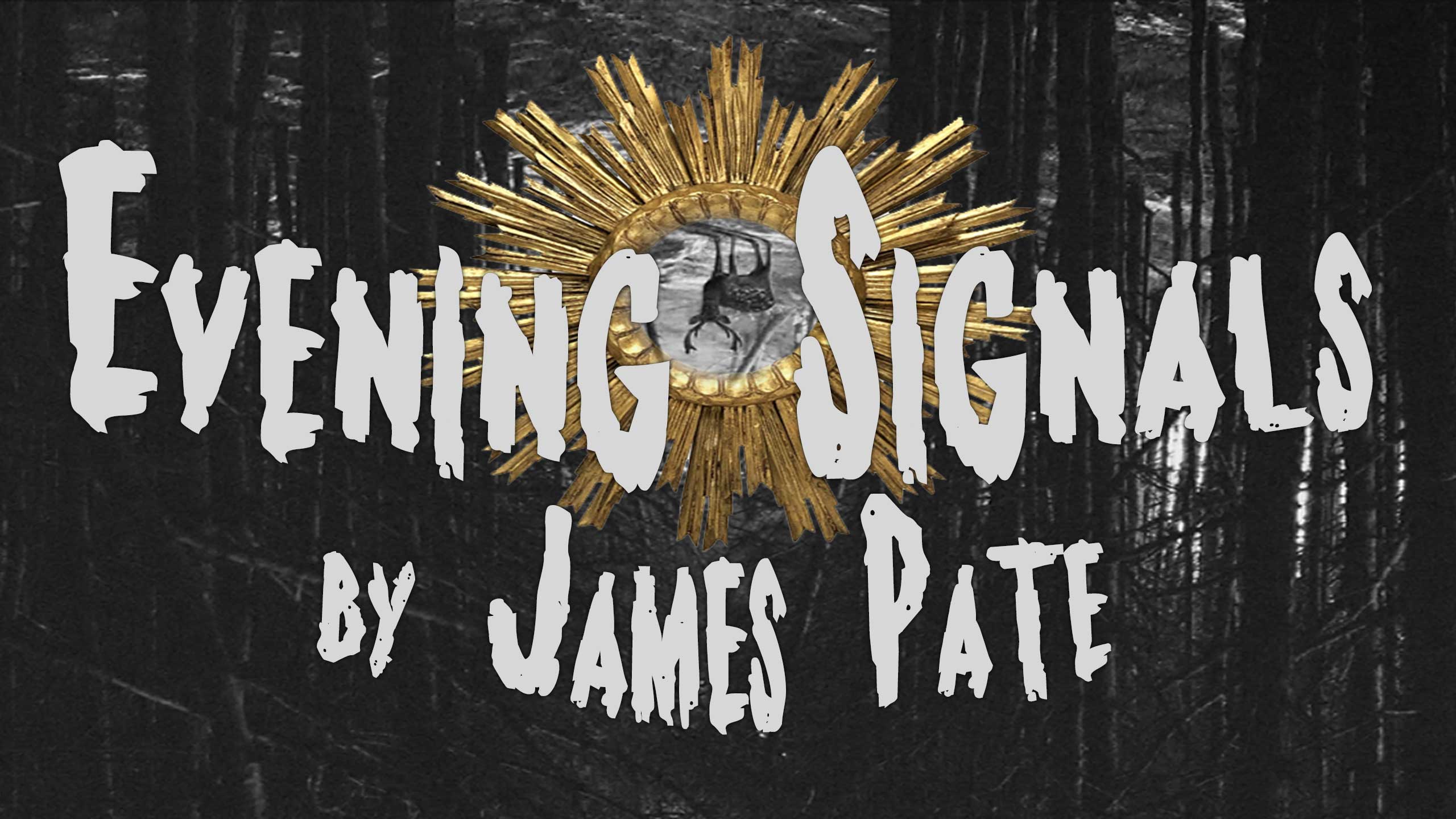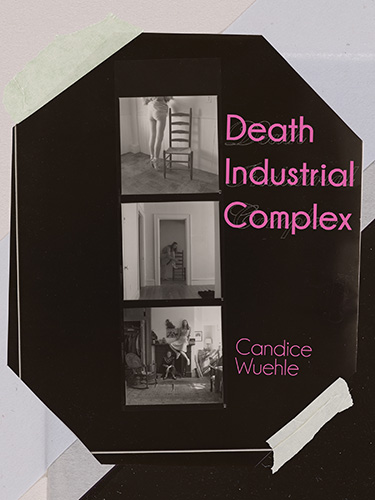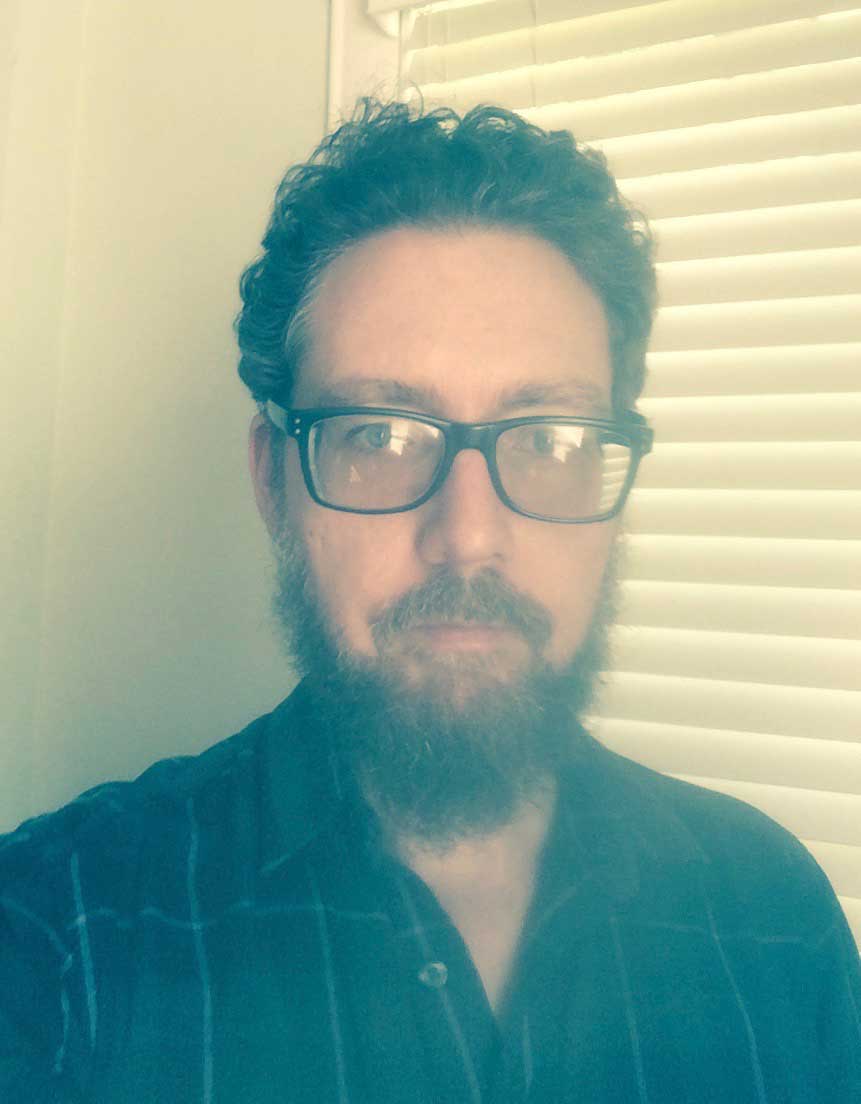Candice Wuehle’s Death Industrial Complex
Evening Signals is a monthly column by James Pate, exploring the Baroque, the Gothic, the Weird and the Fantastique in contemporary poetry and fiction. This month’s column reviews Candice Wuehle’s Death Industrial Complex

Candice Wuehle’s Death Industrial Complex
Evening Signals is a monthly column by James Pate, exploring the Baroque, the Gothic, the Weird and the Fantastique in contemporary poetry and fiction. This month’s column reviews Candice Wuehle’s Death Industrial Complex.
Trigger Warning: This review deals with the topic of suicide
You cannot see me from where I look at myself.
– Francesca Woodman
Candice Wuehle’s Death Industrial Complex (Action Books, 2020) is a collection of interrelated poems that explores the work Francesca Woodman – both her photographs and her writings. Woodman is a complicated figure in the art world. She died in 1981, committing suicide at the age of 22, leaving behind a collection of photographs that have developed a cult following over the years. But her photographs, many of which have strong Gothic overtones (largely empty rooms in a state of disrepair, blurred images of figures that take on a ghostly vibrancy, nude self-portraits in cemeteries, the frequent use of mirrors), have also tended to be held at a distance by the mainstream art world, which isn’t surprising given the masculinist language and aesthetics that is so baked into the mainstream art world sensibility. While reading multiple articles on Woodman’s work during the writing of this review, I was struck by how dismissive critics over the past decades have been towards the shadow side of her work, arguing that Woodman is a great artist despite, and not because of, this occult-ish streak.
In this way, Woodman’s work shares kinship Sylvia Plath’s in the realm of poetry and Shirley Jackson’s in the realm of fiction, all three being women artists who were partially dismissed for their fascination with Death and the uncanny. Woodman and Plath and Jackson were often accepted as talented, but always with that footnote warning the viewer/reader to beware of possible morbidity. This has changed over time. The rise of gender politics and trans rights have helped to erode the masculinist aesthetic assumptions and the old essentialisms that were foundational for the art and literary world – assumptions that coded the Gothic as feminine, and therefore unequal to masculinist Realism and Experimentalism. And cyberspace is making the mainstream art world (and its literary counterpart) increasingly irrelevant as entire art communities now operate outside of the capital-driven dictates of that world. Cyberspace allows for counter communities in a way meatspace never did, and is also a daily reminder of the true neurodiversity of the planet. The superstar artist, the superstar writer – those roles are rapidly vanishing. Mass audiences are being replaced by cult followings.
And it’s this notion of the “cult following” that Wuehle picks up on and explores in Death Industrial Complex. We talk about cult movies, even cult books, as having a “cult following” in order to describe the passionate but relatively small fan base of that work; and yet buried in that phrase is the notion of the cult – that group who has torn itself away from consensus reality to form their own counter reality. Needless to say, many cults have been destructive to its members, and they’re frequently headed by cruel, psychotic men (Charles Manson, Jim Jones). But the term has also often been used to describe certain revolutionary groups, art movements, etc., (admittedly, usually by the detractors of those groups). A group that pulls away from the status quo so thoroughly, that takes seriously the notion of reshaping the world through reshaping reality – the idea fascinates many of us, and maybe especially so now, since we live in such fragmented times.
Wuehle’s book brings both meanings of “cult” into play. What if a cult following in the first sense edged toward a cult following in the second sense? In “Poltergeist II,” she writes, “my cult gathered around a dressmaker’s / dummy, there were about twenty of us; / mostly girls, graduates of institutes of fashion, / women who had been touched by someone in the underground.” “Gathered around a dressmaker’s / dummy” has strongly ritualistic overtones, and this is followed up by “women who had been touched by someone in the underground,” which combines the secular and the spiritual. Woodman was working mostly in the 70s, during the time of many revolutionary underground movements, and the line picks up on that conspiratorial element. But “touched by someone in the underground” also implies each cult member has been touched by a person or entity from Hades, or another Plutonian vision of death. The deft phrase suggests a revolutionary sect devoted to Woodman’s spectral visions – to this space where death is woven into life, and every figure is a blurred crosshatching of shadow and light.
This cult stands in contrast to the death industrial complex mentioned in the title. As Wuehle writes in “iron triangle // cacophobia”:
vince, after I leave tell them not to turn me in
to something else. Don’t let them say I was a pretty
girl. Don’t let them make me part of the death industrial
complex, a thingish photo
of what everyone else should want to be. As if
i meant for anything
except that my cult should stop seeing the echoes
of others; should float.
To escape the “death industrial complex” – to not have her work reduced to a generic “thingish photo / of what everyone should want to be” (“thingish” itself implying something heavy and crude and leaden, so out-of-keeping with Woodman’s playfulness and visual wit)– and to instead have her photographs be for a route that would allow her “cult” to follow their own designs/interests/obsessions, and allow them to “float” – this is Woodman’s hope in the poem. The poem is also threaded through with references to Sylvia Plath, another woman artist with a cult following who committed suicide at a young age. Wuehle’s lines “They’d have us eat our own ash” and “A single head / can contain a million dark red curls” resonate with Plath’s lines (from “Lady Lazarus”) “Out of the ash / I rise with my red hair / And I eat men like air.” And Wuehle’s line “They take one hand and spin / the spiral to convince us to dye it blonde” seems to be in reference to how Plath dyed her red hair platinum blonde after she left the McLean Psychiatric Hospital in Boston. To dye red hair blonde suggests the patriarchal pressures to conform to binary gender roles, to essentialize the self, to repress one’s multiplicity (“a million dark red curls”).
In fact, the opening of “iron triangle // cacophobia” suggests that Woodman herself here is speaking to Plath in an imagined monologue, though Plath’s name is never stated directly. In the context of the Plath references mentioned above, the first line “I hope your heaven isn’t boring” implies that Woodman, through this address, is mediating on Plath’s post-suicide reputation as a way of thinking about her own. (As with many of the poems here, Woodman is speaking posthumously – or possibly from a liminal life-within-death-death-within-life space.) 
Woodman’s suicide, like Plath’s, hovers over her creations. When an artist or writer commits suicide, it can sometimes take effort not to read their work or experience their art – especially those works completed just before suicide – as a final statement, and as a suicide note in itself. A recent example of this is Mark Fisher’s The Weird and the Eerie, his last book before his suicide. The final chapter on how the Outside is manifested in Joan Lindsay’s Picnic at Hanging Rock is unsettling due to the reader’s knowledge that this was the last work Fisher published before his death.
But this approach can be unfair to the art itself, reducing its complexity to a single point (the suicide). In one of the first poems of Death Industrial Complex, Wuehle writes, “My heart is a spiral / shape. No real endpoint; / an anti-suicide note.” “Heart” also includes “art” here, even in the word itself, and in Wuehle’s act of mediumship, Woodman speaks out as an artist who does not want the circumstances of her death to overshadow her art, having it retroactively simplified (giving it an “endpoint”) by dissolving the art into the generalized narrative of the tragic artist. In another poem, Wuehle’s Woodman-ian voice states, “Ignore the idea of observing / from above. Don’t make the girl a specimen / in a godded petri dish.” Instead, we should see “from the side.” That Woodman’s heart/art is spiral-shaped indicates exactly this sidewise (as opposed to top-down) view – a growing out and forth that subverts endpoints, final chapters, final takes. That rejects the male, Olympian gaze. “Ignore the idea of observing / from above” is a fairly clear fuck-you to those masculinists critics who give themselves a God-like status, imagining their judgement dictates what enters cannon-heaven, and what doesn’t. Repeatedly through Death Industrial Complex, Wuehle envisions Woodman subverting the notion of an artist wanting to be seen “from above” by God, or by a critic. She is working for her cult – not for some imagined and internalized final judgment. In “poltergeist I,” Wuehle writes, “i thought it was sort of funny / that the newspapers would call my ascension / a suicide, that they would never notice I was a cult.” The official account (“the newspapers”) sees the death as suicide, while Wuehle/Woodman calls it an ascension – a continual process, a spiraling out and out and out, and not a conclusion. Woodman and her cult know what remains obscured from the newspapers and the view “from above.”
This indifference to official accounts and views from above – to God’s varied secular replacements – is liberatory in Death Industrial Complex, freeing the artist and the cult from patriarchal notions of Greatness and Importance. As Wuehle writes, “Admit I unsober / the spirit of propriety with my heretical prom / dress: teenage royalty / trashing the king / dom of heaven.” Play, performance, wit, humor: these are all attributes that often get overlooked in Woodman’s photography, but Wuehle brings them to the forefront in her act of mediumship [1]. And Wuehle uses the image/concept of the spiral as a way of examining and expressing this playful/performative undercurrent in Woodman’s aesthetic.
The spiral recurs throughout Woodman’s work. Her Eel Series seems to be the most written-about example of this motif, but it also appears in Self-portrait talking to vince, where a spiraling substance is pouring out of Woodman’s mouth, somewhat like a cartoon bubble and somewhat like the ectoplasm that would sometimes spew forth from the mouth of mediums during séances. Wuehle even employs the term “spiralism” throughout the collection to emphasize how this aesthetic is also a politics, a philosophy, a heretical game. “Spiralism” in the sociological sense means a career-path whereby the individual moves upwards through the company, but Wuehle’s spiralism subverts this definition, and instead relates the spiral to an immanent Gothicism – to metamorphoses, mirror reflections, non-linearity.
As Wuehle writes in “I could no longer // c ould not play by instinct”:
i just don’t
grieve; i become the wallpaper,
i become the bark
of the tree and i don’t believe
in loss. i’m going to speak slowly
in the language of the mise en abyme, of
Spiralism.
In Wuehle’s brilliant séance-as-poetry-collection, Woodman refuses to fit into the ready-made role of the tragic artist, or the artist too pure and delicate for this world. In passages like the one above, Woodman seems like a close cousin to Jackson’s Merricat, a figure who lives relentlessly on her own terms, and takes a macabre-edged joy in herself and the space she constructs for herself – a space so scraped of commonplace capitalist, masculinist categories that it seems almost cult-like. An act of magic, or witchcraft. In the last poem of the book, the eerily evocative “terrestrial,” Wuehle writes of Woodman departing from this side of things: “Today I will inhale and exhale / the veil so it ululates like an exterior lung. I’ll / hum the low hum of a s c e n s i o n.” Then the last line repeats over and over, with the words slowly fading until only “hum” remains on the page –the hum her cult continues to hear.
Footnotes
1. One of the very few essays that does really consider Woodman’s playfulness and humor is Rebecca Bengal’s “What We See Now When We Look at Francesca Woodman’s Photographs,” which appeared in Vogue in 2016.

About the Author
James Pate teaches creative writing, literature and philosophy at Shepherd University. His books include The Fassbinder Diaries (CCM, 2013), and Flowers Among the Carrion (Action Book Salvo Series, 2016). His work has appeared in 3:AM Magazine, Black Warrior Review, Burning House Press, Blue Mesa Review, Berkeley Fiction Review, and Occulum, among other places.